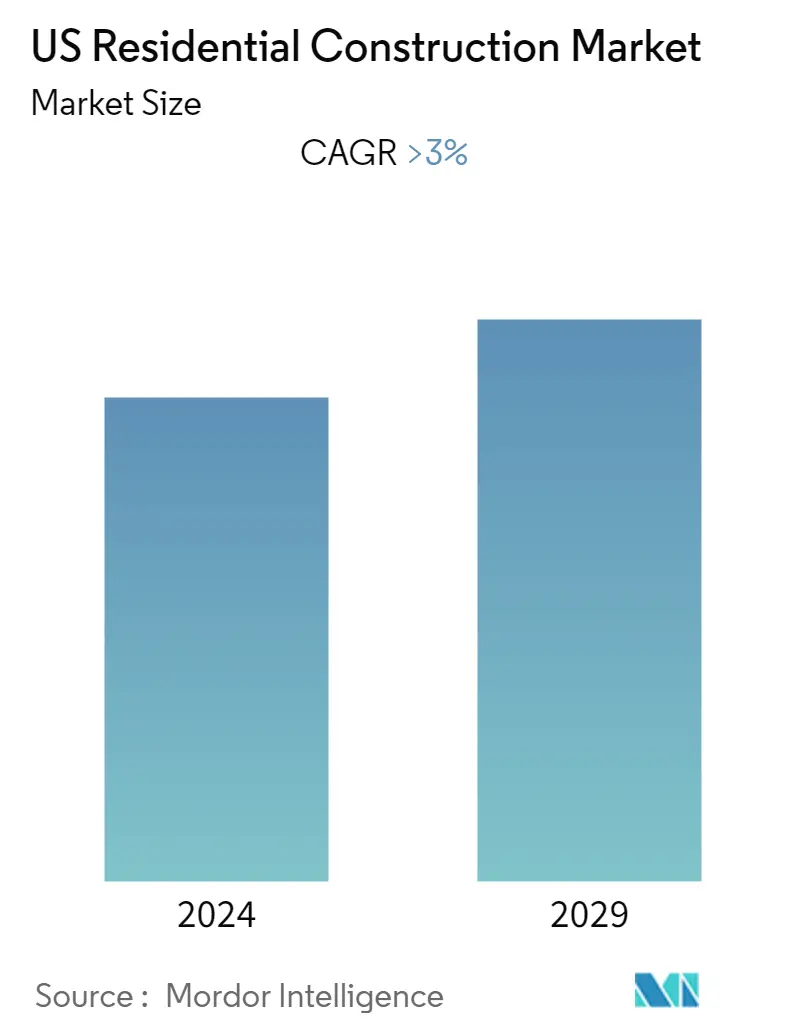Market Size of US Residential Construction Industry

| Study Period | 2020 - 2029 |
| Base Year For Estimation | 2023 |
| Forecast Data Period | 2024 - 2029 |
| Historical Data Period | 2020 - 2022 |
| CAGR | > 3.00 % |
| Market Concentration | Low |
Major Players
*Disclaimer: Major Players sorted in no particular order |
US Residential Construction Market Analysis
The size of the United States Residential Construction Market is around USD 590 billion in the current year and is anticipated to register a CAGR of over 3% during the forecast period. The United States residential construction market is driven by the Affordable Housing trend in the country.
- In 2020, the federal funds rate target was lowered to near zero in response to fears of an economic slowdown from the spread of COVID-19 (coronavirus). Afterward, mortgage rates reached record lows. This, coupled with a low housing supply, fueled residential construction in early 2020. However, the fallout stemming from the coronavirus pandemic was worse than expected, leading to the temporary curtailment or complete shutdown of large bands of the economy. This weighed on residential investment in Q2-2020.
- While other economic indicators embarked on a quick but incomplete rebound, the residential market rebounded exceptionally rapidly, with the value of residential construction investment surpassing pre-pandemic levels before the end of the year 2020. Residential investment was being driven by a low housing stock and historically low mortgage rates. Growth in 2021 accelerated as the release of pent-up demand, alongside increased vaccinations among the population, led to increased residential construction activity. Labor market improvement has also helped support residential demand. Nonetheless, rising inflation in 2022 has pushed the Federal Reserve to raise interest rates to curtail spending amid recessionary fears. As a result, residential investments have slowed considerably with declines expected in 2022 and 2023.
- A divide between construction sectors in the United States has become visible as residential contractors brace for recession - but commercial and industrial buildings continue to boom. Rising interest rates have already driven the single-family homebuilding market into recession, but brisk non-residential activity continues. As recent trends indicate, costs of materials, fulfillment, labor, and land have surged. This had a direct impact on the residential construction industry. Additionally, the negative outlook in the housing market may be creating an even greater perception of discrepancy between the two areas of construction, with higher mortgage rates weighing heavily on demand - or lack thereof - for new housing. Newly released 'Construction Spending' data shows the industry continues to struggle in the current economic environment.
- The data for September 2022 shows that, in seasonally adjusted nominal terms, the industry grew 0.2% from August 2022 and 10.9% compared to the previous year. Overall construction spending growth has remained stable over 2022, mostly maintaining double-digit growth throughout the year. However, as this data is in nominal terms, the expansion mainly reflects the jump in prices across the industry. The balance between residential and non-residential sector growth has also been shifting. The residential sector has shown persistent deceleration in month-on-month (MoM) growth towards the end of 2022, and year-on-year (YoY) growth has followed a downward trend from May 2021. Meanwhile, non-residential construction growth has accelerated, in February 2022, YoY growth turned positive and stood at 9.2% as of September 2022.
US Residential Construction Industry Segmentation
Residential construction is a process that involves the expansion, renovation, or construction of a new home or spaces intended to be occupied for residential purposes. These spaces can be anything from rental spaces, condominiums, and luxury mansions, to single-family housing projects. The United States residential construction market is segmented by Type (Single Family, and Multi-Family), by Construction Type (New Construction and Renovation), and by City (New York City, Los Angeles, San Francisco, Washington DC, Miami, and Other Cities). The report offers market sizes and forecasts for the United States residential construction market (in USD Billion) for all the above segments.
| By Type | |
| Apartment & Condominiums | |
| Villas | |
| Other types |
| By Construction Type | |
| New Construction | |
| Renovation |
| By City | |
| New York City | |
| Los Angeles | |
| San Francisco | |
| Washington DC | |
| Miami | |
| Other Cities |
US Residential Construction Market Size Summary
The United States residential construction market is experiencing a dynamic phase, driven primarily by the trend towards affordable housing. The market, characterized by its fragmented and highly competitive nature, is witnessing significant activity from both major players and emerging small to medium enterprises. The sector's growth trajectory is influenced by various economic factors, including historically low mortgage rates and a limited housing supply, which initially spurred rapid expansion. However, the market has faced challenges due to rising inflation and increased interest rates, leading to a slowdown in residential investments. This has created a noticeable divide between the residential and non-residential construction sectors, with the latter continuing to thrive despite the downturn in residential activities.
Government initiatives and funding have played a crucial role in shaping the market landscape, with substantial investments aimed at enhancing affordable housing options. These efforts are expected to drive growth in the residential construction sector, providing opportunities for market expansion. Major players such as D.R. Horton, Lennar Corp., and PulteGroup are actively competing for market share, while strategic acquisitions and new community developments, like Pulte Homes' Woodland Hill, highlight ongoing efforts to meet consumer demand. Despite the current economic challenges, the market is poised for potential growth, supported by government policies and the ongoing need for affordable housing solutions.
US Residential Construction Market Size - Table of Contents
-
1. MARKET INSIGHTS AND DYNAMICS
-
1.1 Current Market Scenario
-
1.2 Market Drivers
-
1.3 Market Restraints
-
1.4 Market Opportunities
-
1.5 Value Chain / Supply Chain Analysis
-
1.6 Industry Attractiveness - Porter's Five Forces Analysis
-
1.6.1 Threat of New Entrants
-
1.6.2 Bargaining Power of Buyers/Consumers
-
1.6.3 Bargaining Power of Suppliers
-
1.6.4 Threat of Substitute Products
-
1.6.5 Intensity of Competitive Rivalry
-
-
1.7 Insights on Government Regulations in the Market
-
1.8 Insights on Technological Advancements in the Market
-
1.9 Residential Construction Cost Analysis
-
1.10 Impact of COVID-19 on the Market
-
-
2. MARKET SEGMENTATION
-
2.1 By Type
-
2.1.1 Apartment & Condominiums
-
2.1.2 Villas
-
2.1.3 Other types
-
-
2.2 By Construction Type
-
2.2.1 New Construction
-
2.2.2 Renovation
-
-
2.3 By City
-
2.3.1 New York City
-
2.3.2 Los Angeles
-
2.3.3 San Francisco
-
2.3.4 Washington DC
-
2.3.5 Miami
-
2.3.6 Other Cities
-
-
US Residential Construction Market Size FAQs
What is the current US Residential Construction Market size?
The US Residential Construction Market is projected to register a CAGR of greater than 3% during the forecast period (2024-2029)
Who are the key players in US Residential Construction Market?
D.R. Horton, Lennar Corp., PulteGroup, Greystar Worldwide and Alliance Residential are the major companies operating in the US Residential Construction Market.

